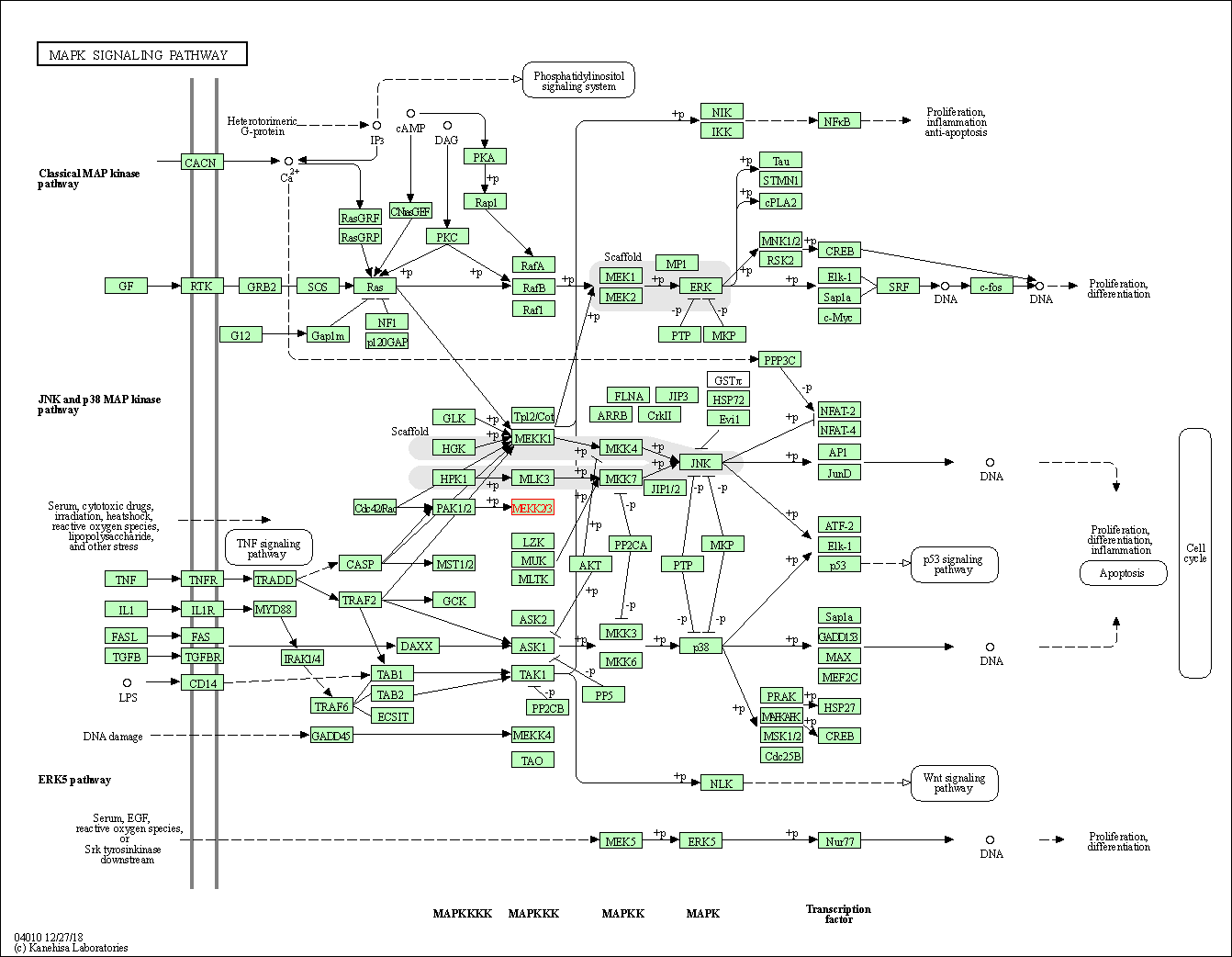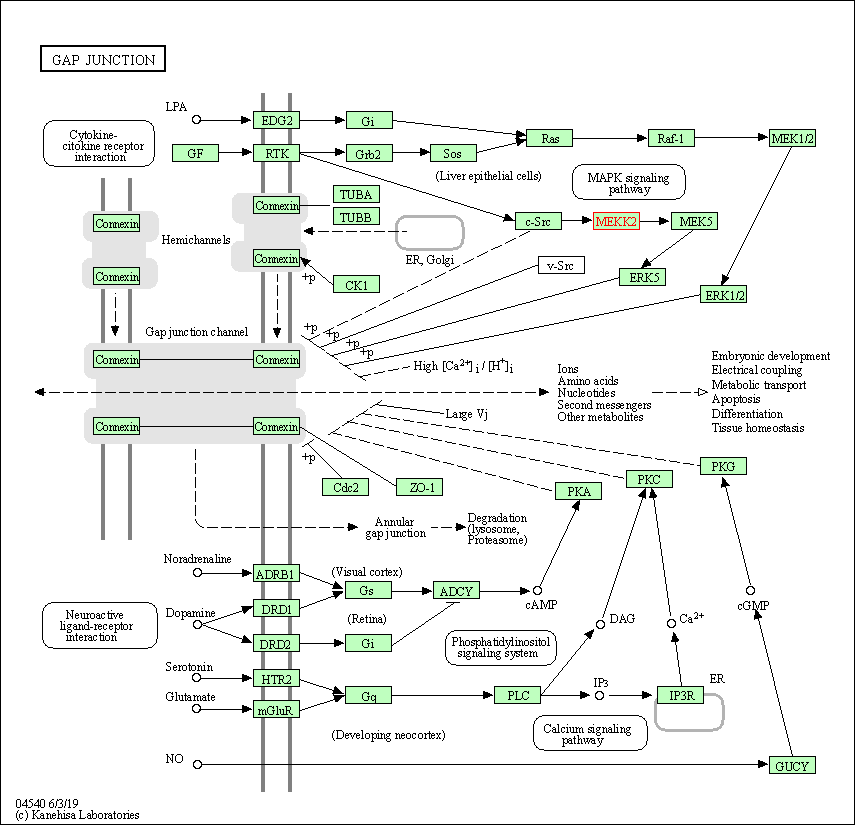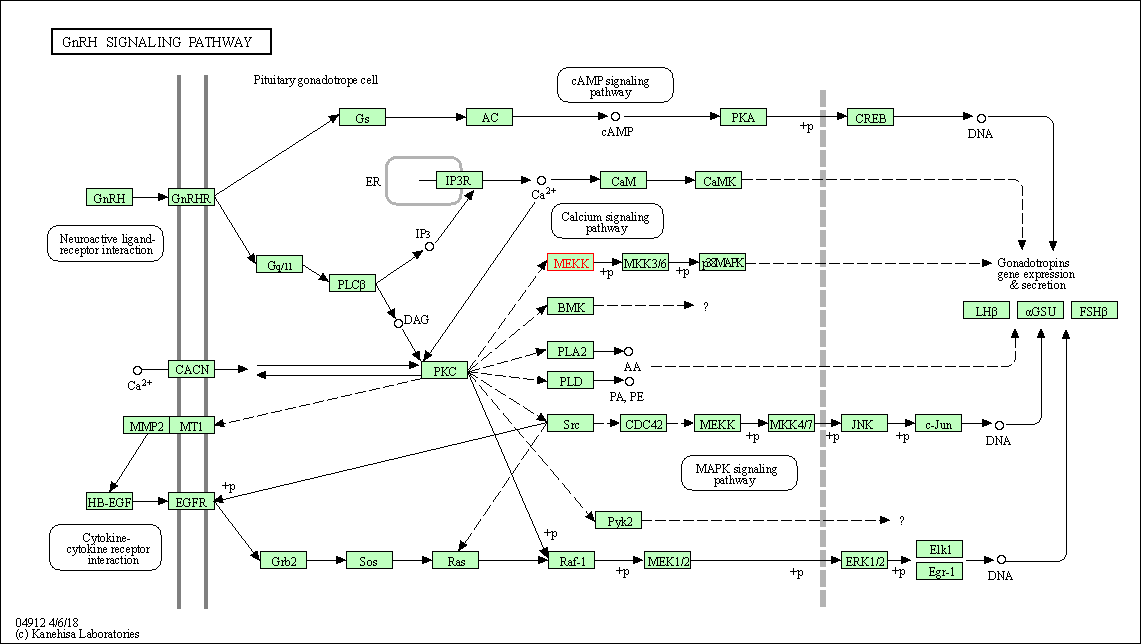Target Information
| Target General Information | Top | |||||
|---|---|---|---|---|---|---|
| Target ID |
T76508
(Former ID: TTDR00337)
|
|||||
| Target Name |
MAPK/ERK kinase kinase 2 (MAP3K2)
|
|||||
| Synonyms |
Mitogen-activated protein kinase kinase kinase 2; MEKK2; MEKK 2; MEK kinase 2; MAPKKK2
Click to Show/Hide
|
|||||
| Gene Name |
MAP3K2
|
|||||
| Target Type |
Clinical trial target
|
[1] | ||||
| Function |
Regulates the JNK and ERK5 pathways by phosphorylating and activating MAP2K5 and MAP2K7. Plays a role in caveolae kiss-and-run dynamics. Component of a protein kinase signal transduction cascade.
Click to Show/Hide
|
|||||
| BioChemical Class |
Kinase
|
|||||
| UniProt ID | ||||||
| EC Number |
EC 2.7.11.25
|
|||||
| Sequence |
MDDQQALNSIMQDLAVLHKASRPALSLQETRKAKSSSPKKQNDVRVKFEHRGEKRILQFP
RPVKLEDLRSKAKIAFGQSMDLHYTNNELVIPLTTQDDLDKAVELLDRSIHMKSLKILLV INGSTQATNLEPLPSLEDLDNTVFGAERKKRLSIIGPTSRDRSSPPPGYIPDELHQVARN GSFTSINSEGEFIPESMDQMLDPLSLSSPENSGSGSCPSLDSPLDGESYPKSRMPRAQSY PDNHQEFSDYDNPIFEKFGKGGTYPRRYHVSYHHQEYNDGRKTFPRARRTQGTSLRSPVS FSPTDHSLSTSSGSSIFTPEYDDSRIRRRGSDIDNPTLTVMDISPPSRSPRAPTNWRLGK LLGQGAFGRVYLCYDVDTGRELAVKQVQFDPDSPETSKEVNALECEIQLLKNLLHERIVQ YYGCLRDPQEKTLSIFMEYMPGGSIKDQLKAYGALTENVTRKYTRQILEGVHYLHSNMIV HRDIKGANILRDSTGNVKLGDFGASKRLQTICLSGTGMKSVTGTPYWMSPEVISGEGYGR KADIWSVACTVVEMLTEKPPWAEFEAMAAIFKIATQPTNPKLPPHVSDYTRDFLKRIFVE AKLRPSADELLRHMFVHYH Click to Show/Hide
|
|||||
| 3D Structure | Click to Show 3D Structure of This Target | AlphaFold | ||||
| Cell-based Target Expression Variations | Top | |||||
|---|---|---|---|---|---|---|
| Cell-based Target Expression Variations | ||||||
| Different Human System Profiles of Target | Top |
|---|---|
|
Human Similarity Proteins
of target is determined by comparing the sequence similarity of all human proteins with the target based on BLAST. The similarity proteins for a target are defined as the proteins with E-value < 0.005 and outside the protein families of the target.
A target that has fewer human similarity proteins outside its family is commonly regarded to possess a greater capacity to avoid undesired interactions and thus increase the possibility of finding successful drugs
(Brief Bioinform, 21: 649-662, 2020).
Human Tissue Distribution
of target is determined from a proteomics study that quantified more than 12,000 genes across 32 normal human tissues. Tissue Specificity (TS) score was used to define the enrichment of target across tissues.
The distribution of targets among different tissues or organs need to be taken into consideration when assessing the target druggability, as it is generally accepted that the wider the target distribution, the greater the concern over potential adverse effects
(Nat Rev Drug Discov, 20: 64-81, 2021).
Human Pathway Affiliation
of target is determined by the life-essential pathways provided on KEGG database. The target-affiliated pathways were defined based on the following two criteria (a) the pathways of the studied target should be life-essential for both healthy individuals and patients, and (b) the studied target should occupy an upstream position in the pathways and therefore had the ability to regulate biological function.
Targets involved in a fewer pathways have greater likelihood to be successfully developed, while those associated with more human pathways increase the chance of undesirable interferences with other human processes
(Pharmacol Rev, 58: 259-279, 2006).
Biological Network Descriptors
of target is determined based on a human protein-protein interactions (PPI) network consisting of 9,309 proteins and 52,713 PPIs, which were with a high confidence score of ≥ 0.95 collected from STRING database.
The network properties of targets based on protein-protein interactions (PPIs) have been widely adopted for the assessment of target’s druggability. Proteins with high node degree tend to have a high impact on network function through multiple interactions, while proteins with high betweenness centrality are regarded to be central for communication in interaction networks and regulate the flow of signaling information
(Front Pharmacol, 9, 1245, 2018;
Curr Opin Struct Biol. 44:134-142, 2017).
Human Similarity Proteins
Human Tissue Distribution
Human Pathway Affiliation
Biological Network Descriptors
|
|
|
Note:
If a protein has TS (tissue specficity) scores at least in one tissue >= 2.5, this protein is called tissue-enriched (including tissue-enriched-but-not-specific and tissue-specific). In the plots, the vertical lines are at thresholds 2.5 and 4.
|
| KEGG Pathway | Pathway ID | Affiliated Target | Pathway Map |
|---|---|---|---|
| MAPK signaling pathway | hsa04010 | Affiliated Target |

|
| Class: Environmental Information Processing => Signal transduction | Pathway Hierarchy | ||
| Gap junction | hsa04540 | Affiliated Target |

|
| Class: Cellular Processes => Cellular community - eukaryotes | Pathway Hierarchy | ||
| GnRH signaling pathway | hsa04912 | Affiliated Target |

|
| Class: Organismal Systems => Endocrine system | Pathway Hierarchy | ||
| Degree | 4 | Degree centrality | 4.30E-04 | Betweenness centrality | 9.46E-06 |
|---|---|---|---|---|---|
| Closeness centrality | 1.92E-01 | Radiality | 1.33E+01 | Clustering coefficient | 1.67E-01 |
| Neighborhood connectivity | 9.25E+00 | Topological coefficient | 3.50E-01 | Eccentricity | 12 |
| Download | Click to Download the Full PPI Network of This Target | ||||
| Chemical Structure based Activity Landscape of Target | Top |
|---|---|
| Drug Property Profile of Target | Top | |
|---|---|---|
| (1) Molecular Weight (mw) based Drug Clustering | (2) Octanol/Water Partition Coefficient (xlogp) based Drug Clustering | |
|
|
||
| (3) Hydrogen Bond Donor Count (hbonddonor) based Drug Clustering | (4) Hydrogen Bond Acceptor Count (hbondacc) based Drug Clustering | |
|
|
||
| (5) Rotatable Bond Count (rotbonds) based Drug Clustering | (6) Topological Polar Surface Area (polararea) based Drug Clustering | |
|
|
||
| "RO5" indicates the cutoff set by lipinski's rule of five; "D123AB" colored in GREEN denotes the no violation of any cutoff in lipinski's rule of five; "D123AB" colored in PURPLE refers to the violation of only one cutoff in lipinski's rule of five; "D123AB" colored in BLACK represents the violation of more than one cutoffs in lipinski's rule of five | ||
| Co-Targets | Top | |||||
|---|---|---|---|---|---|---|
| Co-Targets | ||||||
| Target Poor or Non Binders | Top | |||||
|---|---|---|---|---|---|---|
| Target Poor or Non Binders | ||||||
| Target Regulators | Top | |||||
|---|---|---|---|---|---|---|
| Target-regulating microRNAs | ||||||
| Target-interacting Proteins | ||||||
| Target Affiliated Biological Pathways | Top | |||||
|---|---|---|---|---|---|---|
| KEGG Pathway | [+] 3 KEGG Pathways | + | ||||
| 1 | MAPK signaling pathway | |||||
| 2 | Gap junction | |||||
| 3 | GnRH signaling pathway | |||||
| NetPath Pathway | [+] 3 NetPath Pathways | + | ||||
| 1 | IL5 Signaling Pathway | |||||
| 2 | TGF_beta_Receptor Signaling Pathway | |||||
| 3 | TCR Signaling Pathway | |||||
| Panther Pathway | [+] 3 Panther Pathways | + | ||||
| 1 | B cell activation | |||||
| 2 | EGF receptor signaling pathway | |||||
| 3 | FGF signaling pathway | |||||
| PID Pathway | [+] 2 PID Pathways | + | ||||
| 1 | ErbB1 downstream signaling | |||||
| 2 | Trk receptor signaling mediated by the MAPK pathway | |||||
| WikiPathways | [+] 6 WikiPathways | + | ||||
| 1 | Insulin Signaling | |||||
| 2 | EGF/EGFR Signaling Pathway | |||||
| 3 | MAPK Cascade | |||||
| 4 | MAPK Signaling Pathway | |||||
| 5 | BDNF signaling pathway | |||||
| 6 | IL-1 signaling pathway | |||||
| References | Top | |||||
|---|---|---|---|---|---|---|
| REF 1 | Pharmacological inhibitors of MAPK pathways. Trends Pharmacol Sci. 2002 Jan;23(1):40-5. | |||||
| REF 2 | Discovery, synthesis, and characterization of an orally bioavailable, brain penetrant inhibitor of mixed lineage kinase 3. J Med Chem. 2013 Oct 24;56(20):8032-48. | |||||
If You Find Any Error in Data or Bug in Web Service, Please Kindly Report It to Dr. Zhou and Dr. Zhang.

